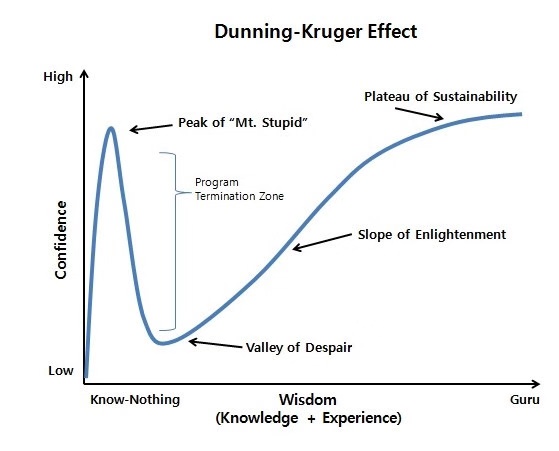最近借着几个周末在 Coursera 上完成了 《Functional Programming Principles in Scala 》,算是终于把之前立的上一门 Coursera 课程的 flag 给做到了。
1. 课程之外
这门课是 Scala 的作者 Martin Odersky, Professor 开的,相比看书,从中能看到更多原汁原味的设计思想,例如为什么会有 Call-By-Name 和 Call-By-Value、Curring 函数等。
学习这门课的时候我脑海里不断的浮现出这条曲线

感觉自己刚看了一个月 scala,就敢写《scala 30分钟极简入门》也是自信心爆棚了。
严格来讲,这门课程不算难,看过《Scala 编程》这本书的话,估计会觉得更轻松一些。不过我之前看的是《Scala 实用指南》,系统知识不全,按照规定时间差不多刚好能做完。几个编程作业都是 100%,最近每个周六日都熬到凌晨三点多也算是值了。
Coursera 上相关课程很多,单独通关或者组队一块上一门课程,都是不错的选择。
2. 课程笔记
由于是笔记,记录的比较杂。课件及作业我上传到了这里
2.1. Week1:Getting Started + Functions & Evaluation
- Call-By-Name Call-By-Value 会带来计算次数的不同,但不是绝对的哪个更加节省计算。If CBV evaluation of an expression e terminates, then CBN evaluation of an expression e terminates, too.The other direction is not true.
def loop: Boolean = loop, A definationdef x = loopis OK, but a definationval x = loopwill lead to an infinite loop.def and(x: Boolean, y: Boolean) = if (x) y else false;def or(x: Boolean, y: Boolean) = if (!x) y else true- @tailrec 可以帮我们验证是否是尾递归
- Exercise 1: Pascal’s Triangle,两种方式,一种是
pascal(r, c) = pascal(r - 1, c - 1) + pascal(r, c - 1),还有一种是pascal(r, c) = C(c, r) = factorial(c) / (factorial(r) * factorial(c -r))。第一种好处是不容易越界,但是重复计算多,递归层数较多。第二种恰好相反,比如factorial(13)就已经比INT32_MAX更大了,容易越界。 - Exercise 2: Parentheses Balancing,对()计数,类似于栈的操作
- Exercise 3: Counting Change:https://stackoverflow.com/questions/12629721/coin-change-algorithm-in-scala-using-recursion,自己最开始只按照coins有序来写的代码,没有通过,思路是一致的。
2.2. Week2:Higher Order Functions
- Functions that take other functions as parameters or that return functions as results is called higher order functions.
- Currying:
def f(args1)...(argsn−1)(argsn) = Eis equivalent todef f = (args1 ⇒ (args2 ⇒ ...(argsn ⇒ E)…)) - 构造函数里可以调用 require,require is a predefined function:
require(y != 0, ”denominator must be nonzero”)
2.3. Week3:Data and Abstraction
- 如果 class 有未定义的 method,那么必须在class前增加 abstract
- Any => the base type of all types
- AnyRef => the base type of all reference types, Alias of ‘java.lang.object’
- AnyVal => the base type of all primitive types.
- Nothing is at the bottom of Scala’s type hierarchy.It’s a subtype of every other type.There is no value of type Nothing. Null is a subtype of every class that inherits from Object;it’s incompatible with subtypes of AnyVal.
if (true) 1 else false的返回值是 AnyVal
2.4. Week4:Types and Pattern Matching
S <: Tmeans: S is a subtype of T.S >: Tmeans: S is a supertype of T, or T is a subtype of S.
Say C[T] is a parameterized type and A, B are types such that A <: B.
In general, there are three possible relationships between C[A] and C[B]
C[A] <: C[B] => C is convariant
C[A] >: C[B] => C is contravariant
neither C[A] nor C[B] is a subtype of the other => C is nonvariant
2.5. Week5:Lists
- Difference between FoldLeft and FoldRight: For operators that are associaive and commutative, foldLeft and foldRight are equivalent(event through there may be a difference in efficiency).
2.6. Week6:Collections
//N-Queens
def isSafe(col: Int, queens: List[Int]): Boolean = {
val row = queens.length
val queensWithRow =
(row - 1 to 0 by -1) zip queens
//println(s"col:$col queensWithRow:${queensWithRow}")
queensWithRow forall {
case (r, c) => col != c && math.abs(col - c) != row - r
}
}
def nqueens(n: Int): Set[List[Int]] = {
def placeQueens(k: Int): Set[List[Int]] = {
if (k == 0) Set(List())
else {
for {
queens <- placeQueens(k - 1)
col <- 0 until n
if (isSafe(col, queens))
} yield col :: queens
}
}
placeQueens(n)
}
3. 杂想
编程语言其实是个挺神奇的东西,可以基础到某些设计思想或者趋势,比如越来越多的语言把类型放到了变量名后面,Types are moving to the right。
函数式编程语言特别像大学里 函数空间 这个概念,大学时最开始学习实数、复数空间时感觉难度不大,到了函数空间,复杂度就一下变高了,天书一样根本听不懂。从对象编程、过程式编程到函数式编程的过程,跟这个非常像,函数变成了一等公民,基于函数的各种组合,我们可以构造出更简洁、高效的模块。
函数式编程给我的最大的感觉是注重函数以及不变量,由于没有可变变量,并发变得比较容易。这门课整体来讲属于入门课程,作者如果开一门 Scala 语言设计思想的课,我应该会第一时间去听吧。
万事开头难,找到知乎的一篇总结帖,准备用业务时间刷下一节课,欢迎组团。
课程里一些简洁同时非常有用的链接:
- https://www.coursera.org/learn/progfun1/supplement/Sauv3/cheat-sheet
- https://www.coursera.org/learn/progfun1/supplement/D9pm0/learning-resources
- https://www.coursera.org/learn/progfun1/supplement/KPiGt/scala-style-guide
- https://www.scala-lang.org/api/current/index.html
- http://twitter.github.io/scala_school/